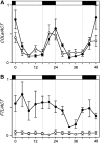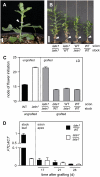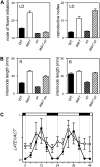Pea LATE BLOOMER1 is a GIGANTEA ortholog with roles in photoperiodic flowering, deetiolation, and transcriptional regulation of circadian clock gene homologs
- PMID: 17468223
- PMCID: PMC1914181
- DOI: 10.1104/pp.107.096818
Pea LATE BLOOMER1 is a GIGANTEA ortholog with roles in photoperiodic flowering, deetiolation, and transcriptional regulation of circadian clock gene homologs
Abstract
Genes controlling the transition to flowering have been studied in several species, including Arabidopsis (Arabidopsis thaliana) and rice (Oryza sativa), but have not yet received much attention in legumes. Here, we describe a new allelic series of late-flowering, photoperiod-insensitive mutants in the pea (Pisum sativum) LATE BLOOMER1 (LATE1) gene and show that LATE1 is an ortholog of Arabidopsis GIGANTEA. Mutants display defects in phytochrome B-dependent deetiolation under red light and in the diurnal regulation of pea homologs of several Arabidopsis circadian clock genes, including TIMING OF CAB1, EARLY FLOWERING4, and CIRCADIAN CLOCK ASSOCIATED1/LATE ELONGATED HYPOCOTYL. LATE1 itself shows strongly rhythmic expression with a small but distinct acute peak following dark-to-light transfer. Mutations in LATE1 prevent the induction of a FLOWERING LOCUS T (FT) homolog FTL in long days but cause only minor alteration to the rhythmic expression pattern of the only known group Ia CONSTANS homolog COLa. The late-flowering phenotype of late1 mutants can be completely rescued by grafting to the wild type, but this rescue is not associated with a significant increase in FTL transcript level in shoot apices. Genetic interactions of late1 with the photoperiod-insensitive, early-flowering sterile nodes (sn) mutant and impairment of the LATE1 diurnal expression rhythm in sn plants suggest that SN may also affect the circadian clock. These results show that several functions of Arabidopsis GIGANTEA are conserved in its pea ortholog and demonstrate that genetic pathways for photoperiodic flowering are likely to be conserved between these two species. They also suggest that in addition to its role in the floral transition, LATE1 also acts throughout reproductive development.
Figures







Similar articles
-
DIE NEUTRALIS and LATE BLOOMER 1 contribute to regulation of the pea circadian clock.Plant Cell. 2009 Oct;21(10):3198-211. doi: 10.1105/tpc.109.067223. Epub 2009 Oct 20. Plant Cell. 2009. PMID: 19843842 Free PMC article.
-
Two new clock proteins, LWD1 and LWD2, regulate Arabidopsis photoperiodic flowering.Plant Physiol. 2008 Oct;148(2):948-59. doi: 10.1104/pp.108.124917. Epub 2008 Aug 1. Plant Physiol. 2008. PMID: 18676661 Free PMC article.
-
Circadian clock proteins LHY and CCA1 regulate SVP protein accumulation to control flowering in Arabidopsis.Plant Cell. 2008 Nov;20(11):2960-71. doi: 10.1105/tpc.108.061531. Epub 2008 Nov 14. Plant Cell. 2008. PMID: 19011118 Free PMC article.
-
Update on the genetic control of flowering in garden pea.J Exp Bot. 2009;60(9):2493-9. doi: 10.1093/jxb/erp120. Epub 2009 May 4. J Exp Bot. 2009. PMID: 19414500 Review.
-
Circadian clock and photoperiodic response in Arabidopsis: from seasonal flowering to redox homeostasis.Biochemistry. 2015 Jan 20;54(2):157-70. doi: 10.1021/bi500922q. Epub 2014 Dec 30. Biochemistry. 2015. PMID: 25346271 Free PMC article. Review.
Cited by
-
Molecular identification of 1-Cys peroxiredoxin and anthocyanidin/flavonol 3-O-galactosyltransferase from proanthocyanidin-rich young fruits of persimmon (Diospyros kaki Thunb.).Planta. 2009 Sep;230(4):841-55. doi: 10.1007/s00425-009-0989-0. Epub 2009 Jul 30. Planta. 2009. PMID: 19641937 Free PMC article.
-
The timing of GIGANTEA expression during day/night cycles varies with the geographical origin of Arabidopsis accessions.Plant Signal Behav. 2017 Jul 3;12(7):e1342026. doi: 10.1080/15592324.2017.1342026. Epub 2017 Jun 23. Plant Signal Behav. 2017. PMID: 28644109 Free PMC article.
-
Molecular and geographic evolutionary support for the essential role of GIGANTEAa in soybean domestication of flowering time.BMC Evol Biol. 2016 Apr 12;16:79. doi: 10.1186/s12862-016-0653-9. BMC Evol Biol. 2016. PMID: 27072125 Free PMC article.
-
Similarities in the circadian clock and photoperiodism in plants.Curr Opin Plant Biol. 2010 Oct;13(5):594-603. doi: 10.1016/j.pbi.2010.05.004. Curr Opin Plant Biol. 2010. PMID: 20620097 Free PMC article. Review.
-
Environmental and molecular analysis of the floral transition in the lower eudicot Aquilegia formosa.Evodevo. 2011 Feb 17;2:4. doi: 10.1186/2041-9139-2-4. Evodevo. 2011. PMID: 21329499 Free PMC article.
References
-
- An H, Roussot C, Suárez-López P, Corbesier L, Vincent C, Pineiro M, Hepworth S, Mouradov A, Justin S, Turnbull C, et al (2004) CONSTANS acts in the phloem to regulate a systemic signal that induces photoperiodic flowering of Arabidopsis. Development 131 3615–3626 - PubMed
-
- Ben-Naim O, Eshed R, Parnis A, Teper-Bamnolker P, Shalit A, Coupland G, Samach A, Lifschitz E (2006) The CCAAT binding factor can mediate interactions between CONSTANS-like proteins and DNA. Plant J 46 462–476 - PubMed
-
- Beveridge CA, Murfet IC (1996) The gigas mutant in pea is deficient in the floral stimulus. Physiol Plant 96 637–645
-
- Blázquez MA, Ahn JH, Weigel D (2003) A thermosensory pathway controlling flowering time in Arabidopsis thaliana. Nat Genet 33 168–171 - PubMed
Publication types
MeSH terms
Substances
Associated data
- Actions
LinkOut - more resources
Full Text Sources
Other Literature Sources
Molecular Biology Databases
Research Materials
Miscellaneous

